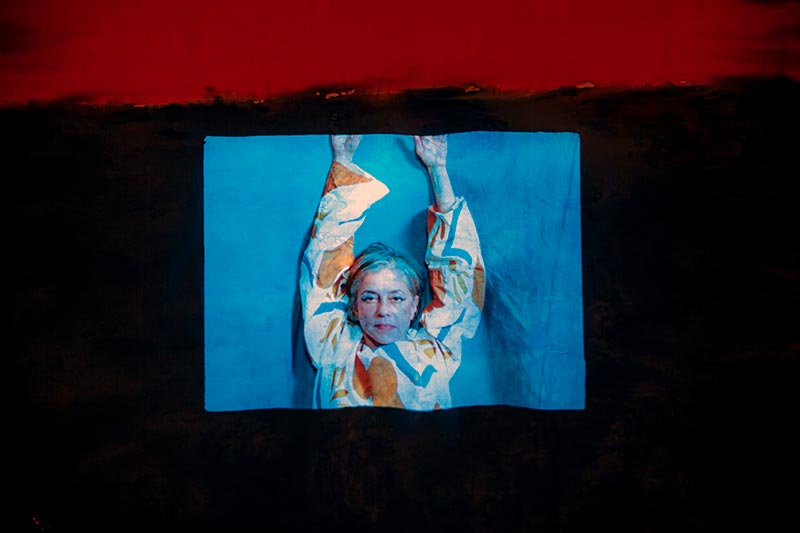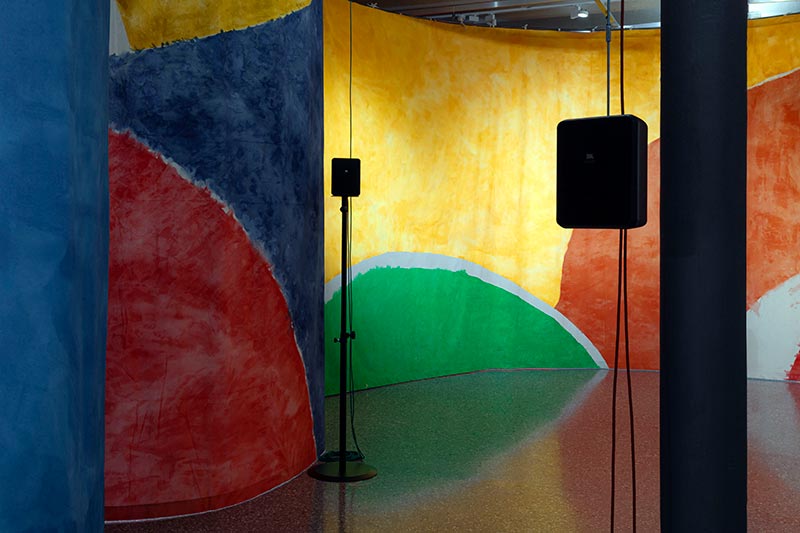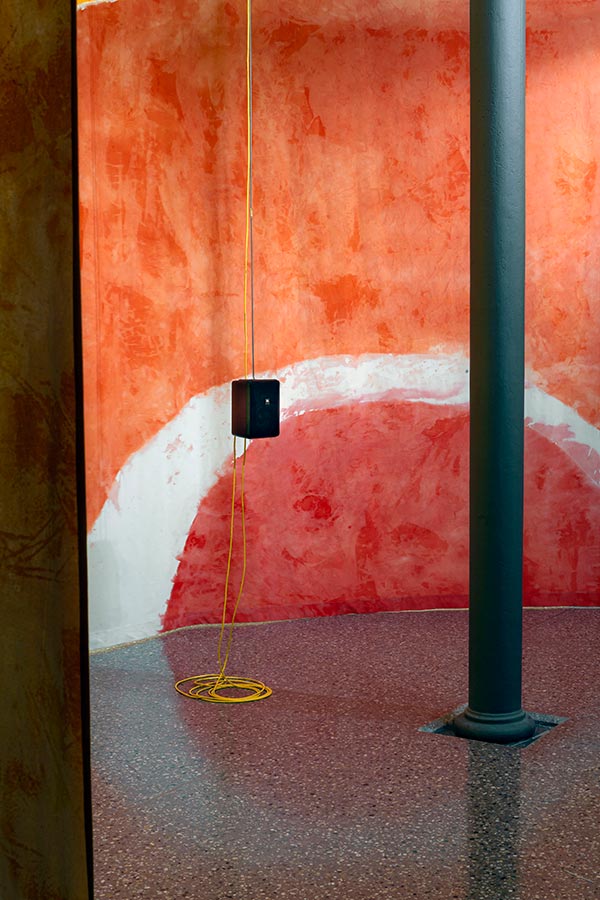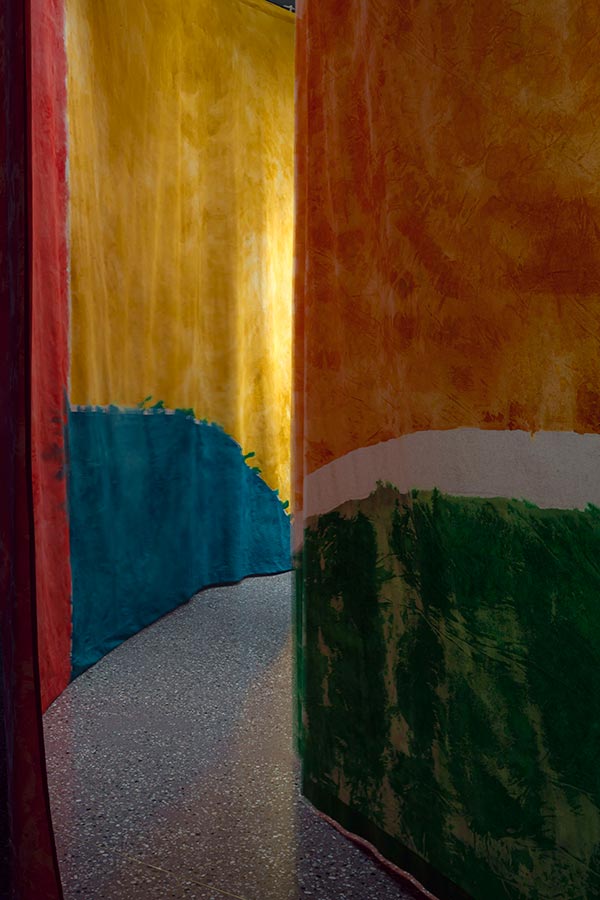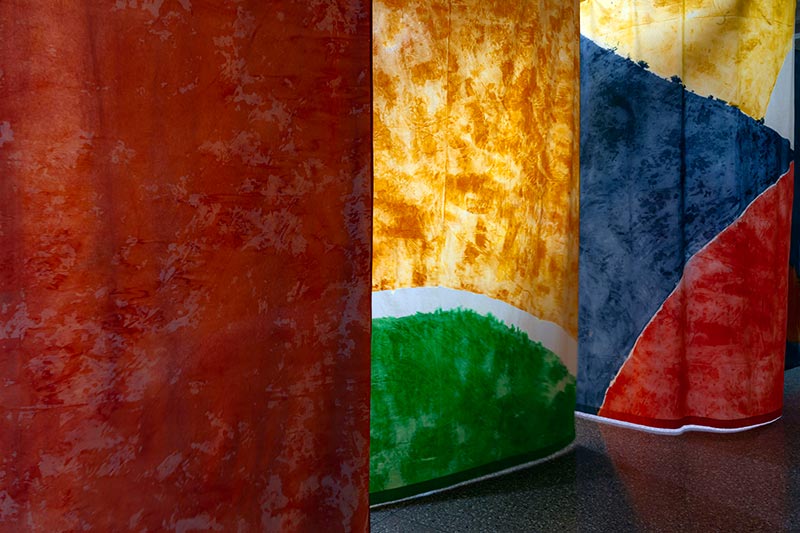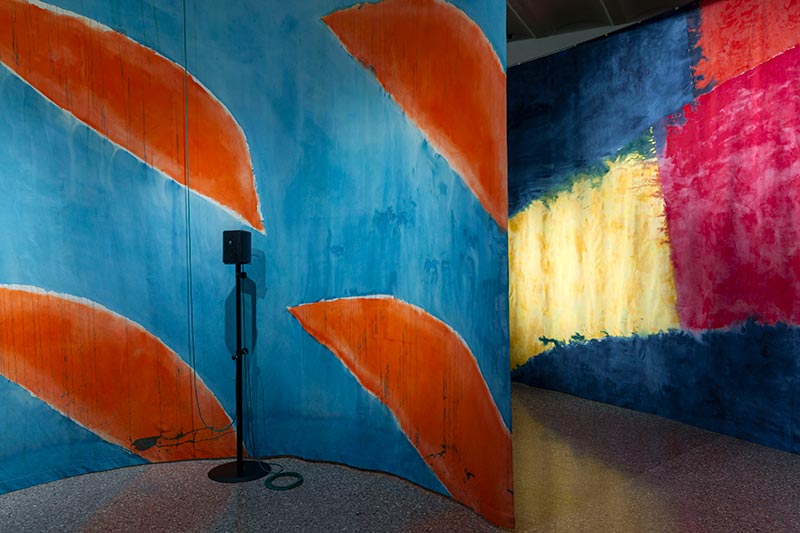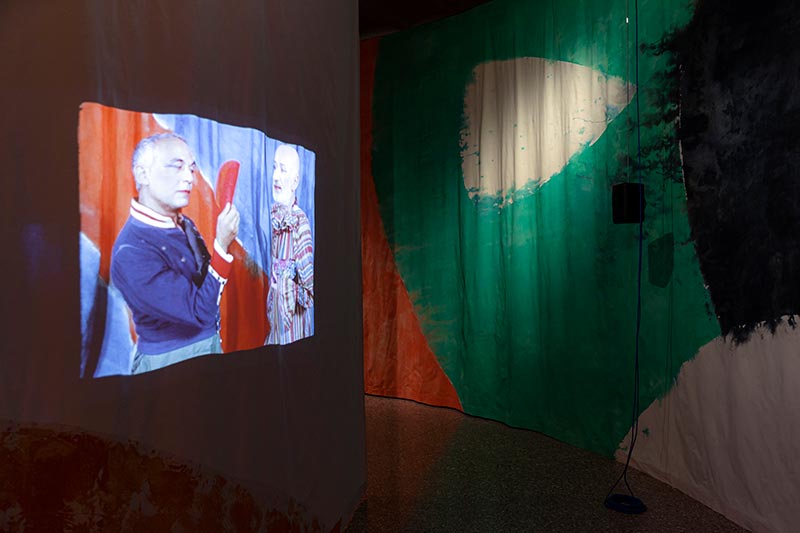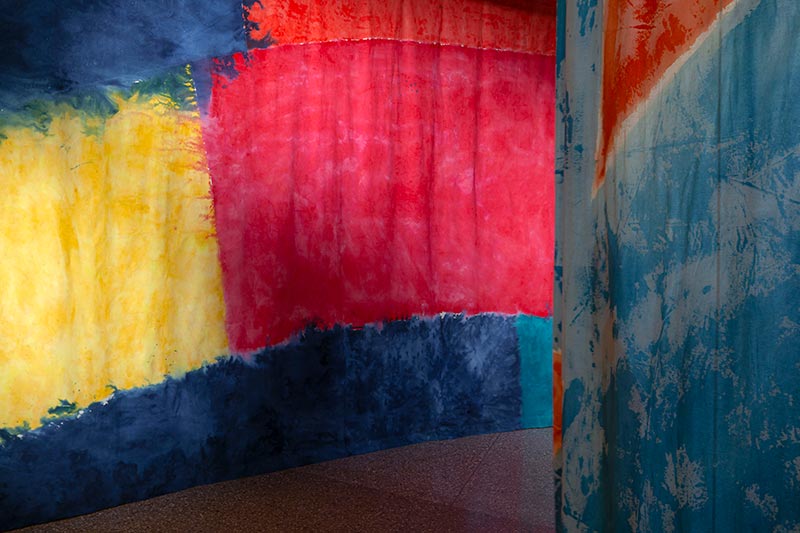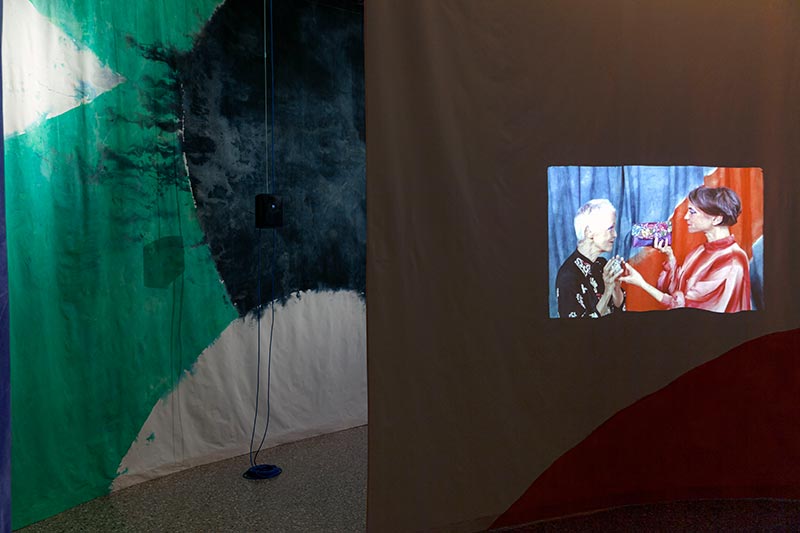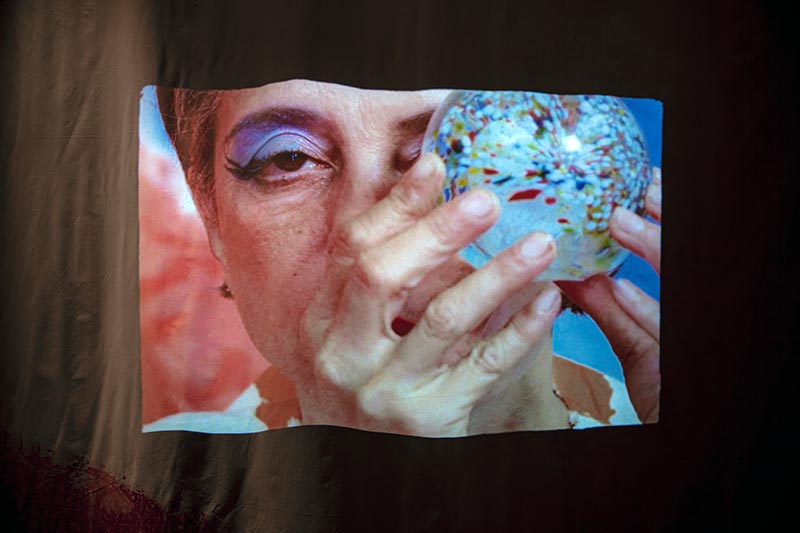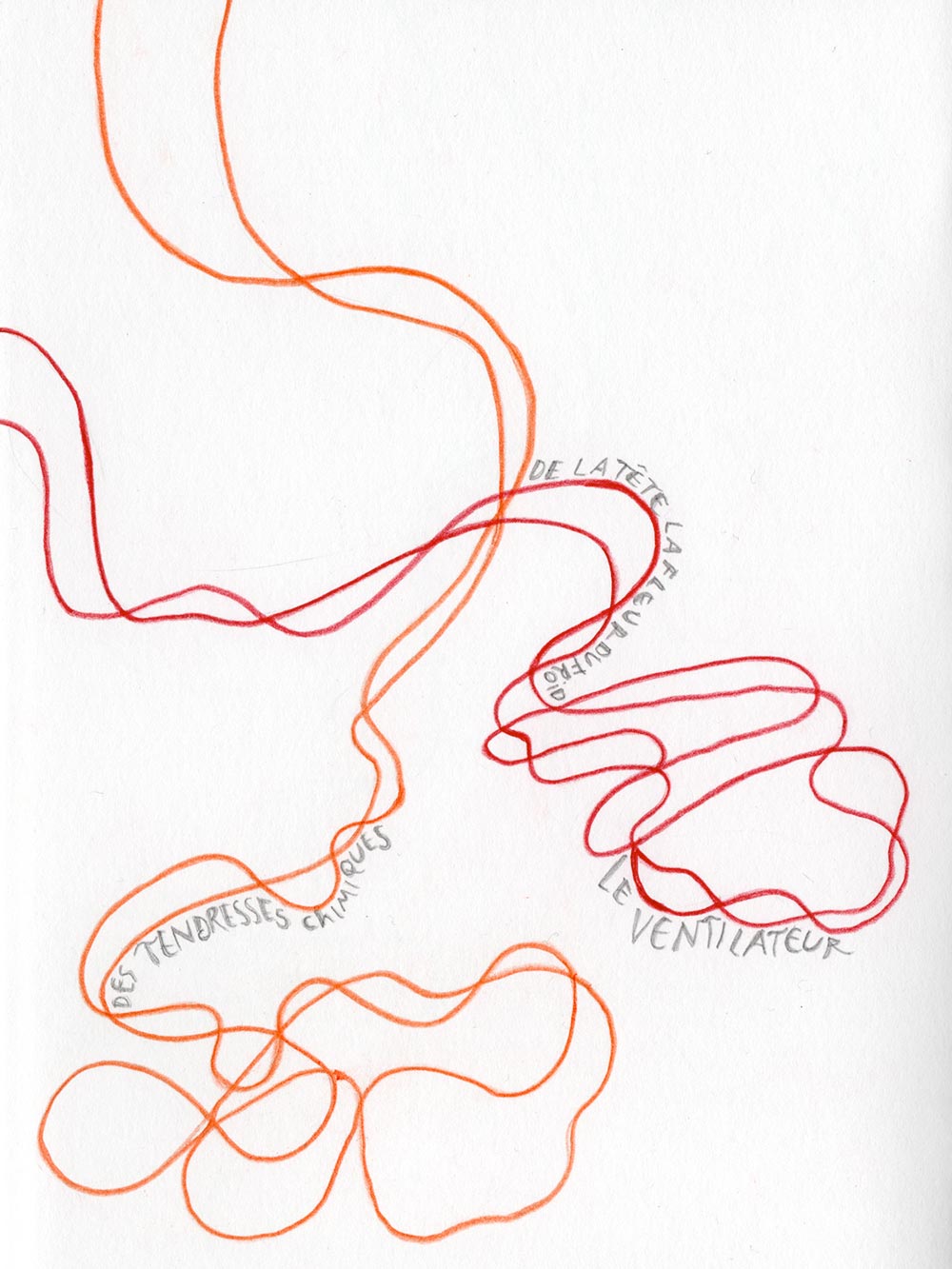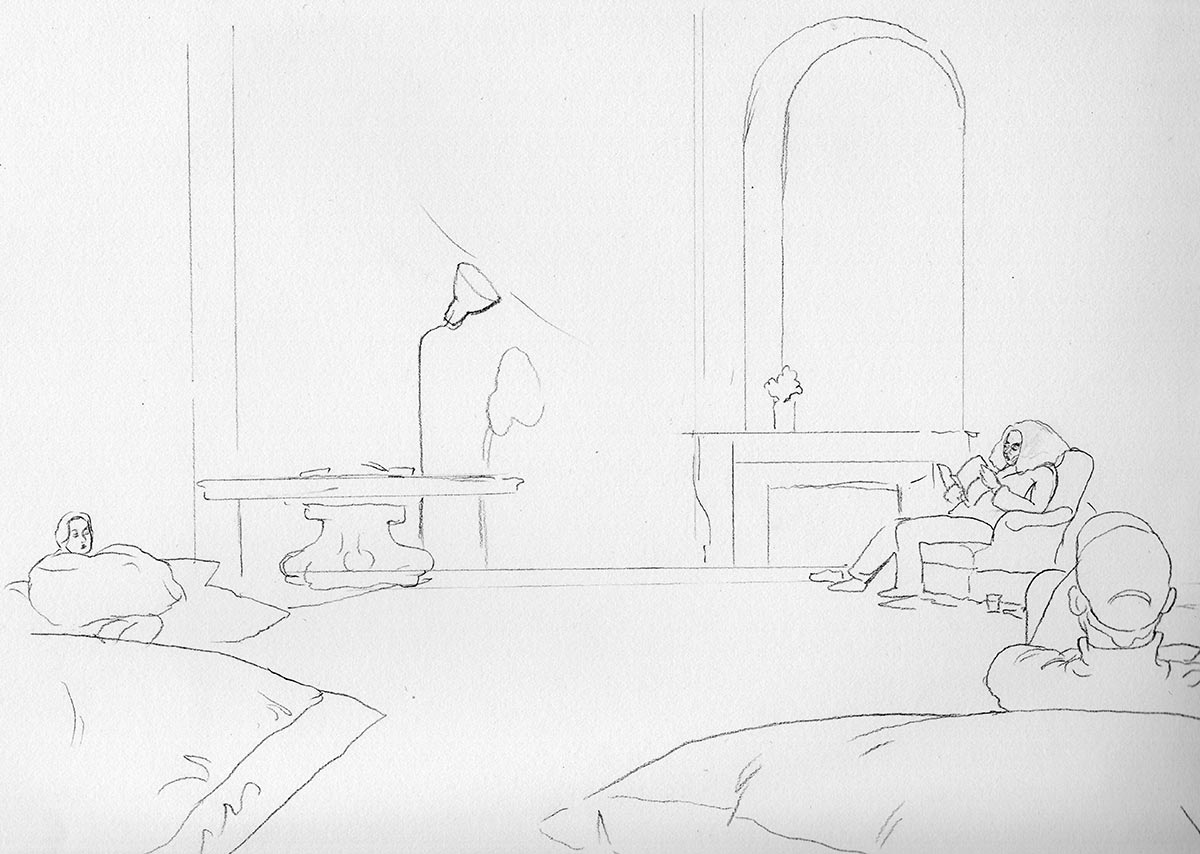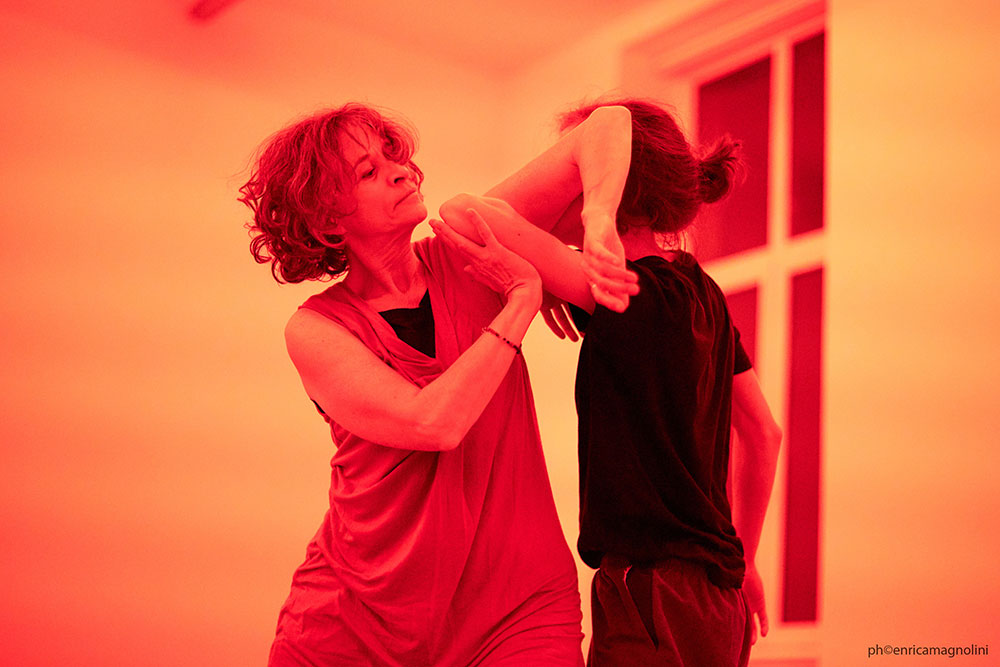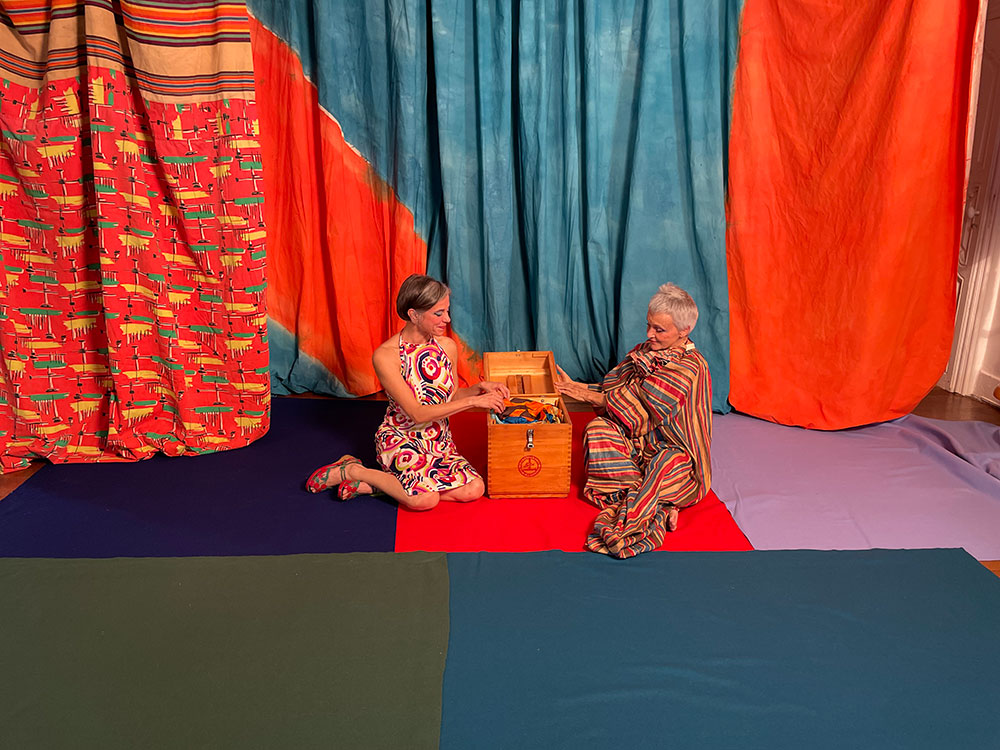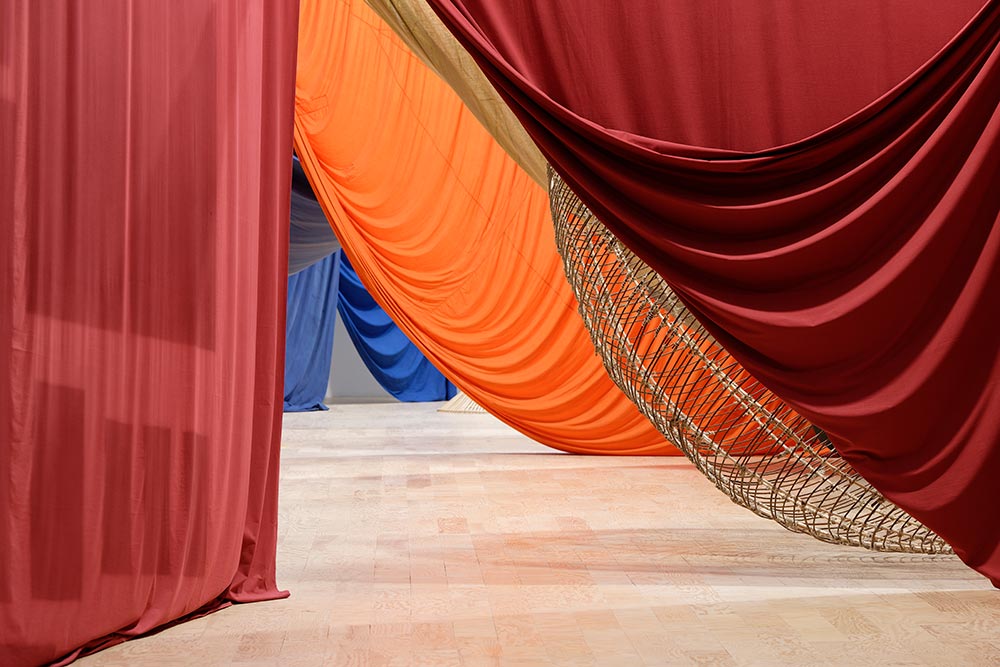Meris Angioletti e Ulla von Brandenburg
Sul vestito lei ha un corpo. Note su Sonia Delaunay
[On her dress she wears a body. Notes on Sonia Delaunay]
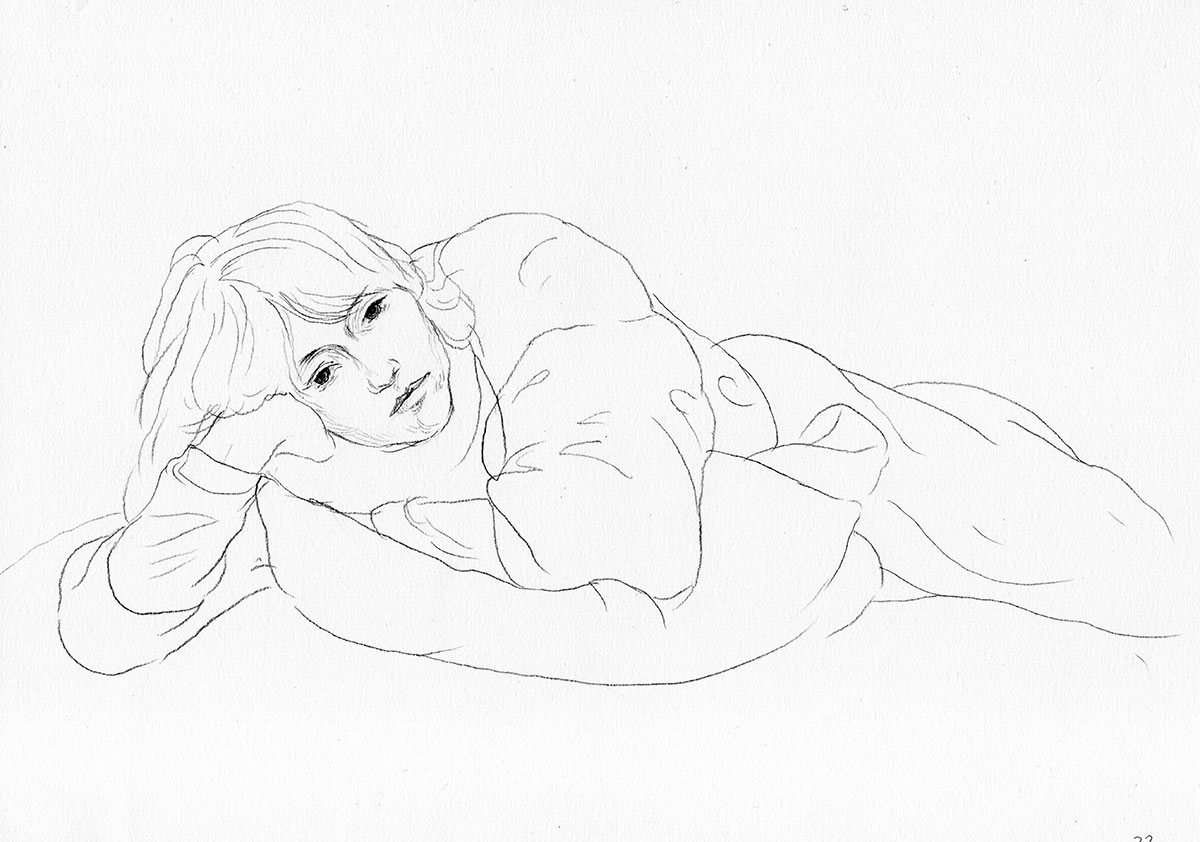
Meris Angioletti, Cercle de lecture autour du roman gothique : Perils of the Night. Pour B., giovedì 20 dicembre/venerdì 21 dicembre 2018 dalle 20:00 alle 06:00, carta da parati, bibliografia, disegni. In collaborazione con Alice Labourg. Disegni di Miyuka Schipfer. Courtesy l’artista, MABA, Nogent-sur-Marne.
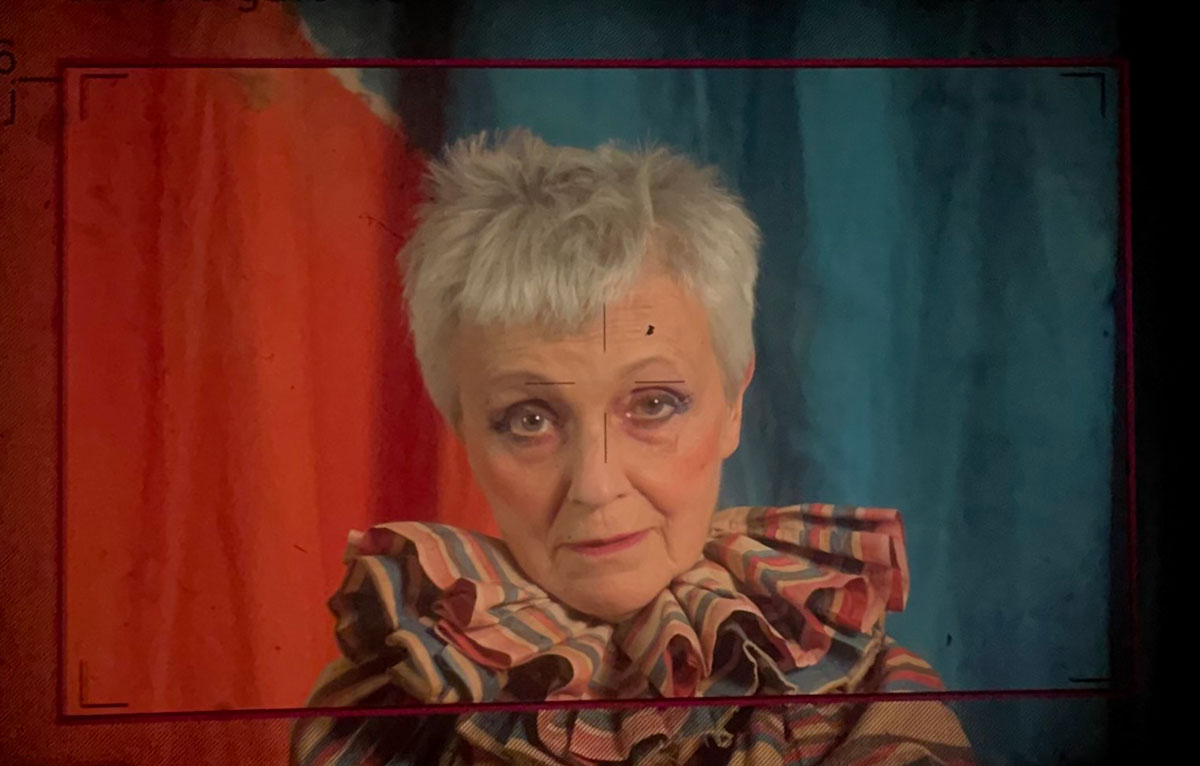
Ulla von Brandenburg, La fenêtre s’ouvre comme une orange, 2022. Diciassette tele dipinte, nastro, corda (dimensioni variabili) e tre film super 16 mm trasferiti in video hd, colori, muto (durate variabili, edizione di 5 + 2 PA). Cortesia dell’artista, della Fondazione di Piacenza e Vigevano e delle gallerie: Art : Concept (Parigi); Meyer Riegger (Berlino/Karlsruhe); Pilar Corrias Gallery (Londra) e Produzentengalerie Hamburg (Amburgo). Concettualizzazione scenografica da Julia Mossé.
DATE:
24 November 2022
18 June 2023
INFO:
Friday-Sunday:
10.30-19.30
By reservation for
schools and groups
Free Entry
DOWNLOAD:
SHARE:
An exhibition that is like a dress to wear. A reflection on colour and sound, where colours become numbers and their relationships create rhythms. An exhibition conceived as a creative workshop, where painting, sculpture, poetry, music, cinema, and performance coexist and simultaneously dress – and redress – our bodies in motion. Extended to 18 June 2023, from 20 May the exhibition is enriched with a new loan, with the Syncopé tapestry created by Delaunay in 1975.
Curated by Paola Nicolin.
From 24th November 2022, XNL Piacenza, the Centre for Contemporary Arts, Cinema, Theatre, and Music of the Piacenza and Vigevano Foundation opens Sul vestito lei ha un corpo. Note su Sonia Delaunay [On her dress she wears a body. Notes on Sonia Delaunay], the exhibition project by Meris Angioletti and Ulla von Brandenburg, the artists invited to reflect on the figure of the Russian-French artist Sonia Delaunay, (Odessa, Ukraine 1885 – Paris, France 1979).
As an artist capable of implementing the project of a futuristic refoundation of the world, Sonia Delaunay cultivated a particular predisposition to create abstract paintings that trespass the physical frame. She worked on the dynamics and interaction of colours to develop a very personal expressive vocabulary, which is often identified with the concept of simultaneity. Together with her husband Robert, the artist tirelessly investigated the perceptual nature of colour, the pure essence of painting, relying only on colour, and extended this pictorial position engaging simultaneously in various disciplines – from painting to design, from fashion to poetry, from cinema to sculpture and the publishing industry…– within a unique aesthetic rendering of multiple aspects of life.
In 1913, Sonia turned a dress into her manifesto: her first “simultaneous dress” was built through a combination of colours and shapes, and embodied the message of an anti-modern, androgynous modernity, neither masculine nor feminine, fast-moving, and fluid, where the body is seen as a laboratory for aesthetic and social research. From the vast network of poets and writers surrounding the couple during their life in Paris, Blaise Cendras (1887-1961), friend and poet, composed a poem in honour of the dress, Sur la robe elle a un corps, from which the title of this exhibition is taken.
The project stems from an invitation to two contemporary artists – Meris Angioletti (Bergamo, 1977, working and living in Paris) and Ulla von Brandenburg (Karlsruhe 1974, working and living in Paris) – to reflect on the figure of Sonia Delaunay, and particularly on the experience of Atelier Simultané (1923-1934), an extension of her Paris home atelier in Boulevard Malesherbes, where Sonia Delaunay lived with her husband Robert.
The project stems from an invitation to two contemporary artists – Meris Angioletti (Bergamo, 1977, working and living in Paris) and Ulla von Brandenburg (Karlsruhe 1974, working and living in Paris) – to reflect on the figure of Sonia Delaunay, and particularly on the experience of Atelier Simultané (1923-1934), an extension of her Paris home atelier in Boulevard Malesherbes, where Sonia Delaunay lived with her husband Robert.
The Atelier became a pole of attraction for the vast network of relationships cultivated by the couple over the years, which included some of the most significant poets, musicians, and artists of their generation. It was a creation space open to several activities, where the artist developed the unitary and simultaneous nature of the arts through a systematic analysis of the relationships between colour and shape.
Angioletti and von Brandenburg have been invited to reflect on this historical episode – still relevant today – as an example of research on the distinctive nature of fabric, on the different translations of pure painting into imagines in motion, voice, and space, and on the idea itself of art as an open field where the body acts and learns through action. The proposal for a dialogue on Sonia Delaunay is an open question on our time, on the idea of simultaneity as human being-society-space relationship, as the pace of our living, as condition of those who are perpetually trespassing, changing, and mutating.
Sul vestito lei ha un corpo, the title chosen for this exhibition draws the attention on the themes of the project: fabric and body, poetry and voice, word and gesture, time and space.
Each with her own expressive language, both artists have been working for years on the border between various disciplines, questioning themselves on the relationships among fabric, poetry, dance, cinema, theatre, and sound as tools of social and psychological investigation, and orchestrating rituals, literature, popular culture, theatre, and poetry into existential installations which are conceived as sets for possible hypotheses.
Artist and researcher, Meris Angioletti focuses her work on the relationship between language and body. Poetry, literature, psychology, papers in physics and mathematics, but also tarots and rituals provide the basis for research on the visible and the invisible, on the part and the whole, between awareness and unawareness. These references are the core of an art that takes the shape of sound installations and tracks, performances, night readings, choreographies, projections of light, colour, and images. The voice is the raw material used by the artist to create her work through different phases of translation.
The work of Ulla von Brandenburg is a peculiar example of research on the relationship between fabric and body. The latter is experienced as a material that creates and transforms space leading to “other” behaviours, and it often becomes the curtain for video projections of previous performances staged by the artist herself. Cinema, theatre, performance, literature, and historic characters are the elements of a complex poetics, which over the years has been skilfully translated into 3-D sceneries of colour and shapes.
Angioletti and von Brandenburg are the protagonists of the main gallery, where together they build an exhibit-exhibition consisting of a fabric installation, a series of new films (von Brandenburg), and a vast sound project (Angioletti).
The gallery is preceded by a space set up to look like a time chamber: on display is a selection of gouaches by Sonia Delaunay coming from the Gió Marconi Gallery in Milan, and a series of exhibits connected to the artist’s poetics.
The exhibition Sul vestito lei ha un corpo. Note su Sonia Delaunay inaugurates a series of events dedicated to the dialogue between modern and contemporary art, whose aim is to reinterpret some chapters of the history of art from a multi-media and non-linear perspective mixing languages and timelines, with a special focus on the protagonists of an irregular modernity, those artists who were able to intercept the sensibility and attitude of the future ahead of their time.
The exhibition will be accompanied by a series of artist’s ateliers designed by Meris Angioletti, which once again confirm the institution’s desire to reflect on the concept of museum-atelier, i.e., a museum conceived as a meeting place for different disciplines, and as a location for productive workshops that foster the creation of relationships with the territory and its cultural infrastructures through the experience of artistic practices.
Meris Angioletti was born in Italy in 1977, lives and works in Paris, where she is currently PhD researcher at Institut ACTE, Université Paris 1 – Panthéon Sorbonne. Rooted as much in the history of the arts – from the first abstract works at the end of the 19th century to the “expanded cinema” theorized by Gene Youngblood in the 1970s – as in the cognitive sciences, psychology, and esoteric beliefs, Meris Angioletti’s works question the mechanisms of perception, memory, voice and language.
She held personal exhibitions at ENSAPC YGREC, Paris (“L’Anneau et le livre”, 2017) at FRAC Champagne – Ardenne, Reims (“Le Grand jeu”, 2016), at Galerie – Centre d’art contemporain, Noisy-Le-Sec, in 2011 at the Fondazione Galleria Civica di Trento (“ I describe the Way and meanwhile I am proceeding along it”) and at GAMeC – Galleria Arte Moderna e Contemporanea in Bergamo (“Ginnastica Oculare”), both in Italy, in 2009.
Her work has been exhibited worldwide, including at Fondation d’entreprise Ricard in Paris (“Prix Ricard – Bonaventura. Trafiquer les mondes”, 2021) at the 53th São Paulo Biennial (“Imminence of Poetics”, 2012), the 54th Venice Biennale (“IllumiNations”, 2011), the 5th edition of Nouveau Festival and at the Centre Pompidou (“L’oubli, le souvenir, la réminiscence”, 2014).
Ulla von Brandenburg is a German artist born in 1974 in Karlsruhe and based in Paris since 2005. After training as a scenographer in Karlsruhe and a brief period spent in the world of the theatre, she studied at the Hochschule für Bildende Künste in Hamburg. Her work is characterised by a diversity of means and media (installations, films, watercolours, murals, collages, performances…) that answer to one another and which she stages according to different exhibition spaces. Perfectly mastering the codes of scenography, nourished by literature, the history of the arts and architecture but also psychanalysis, spiritism and magic, she derives as much from esoteric rituals and popular ceremonies, as from the mechanisms and codes of the theatre, to explore the construction of our social structures. Masks, costumes, sets and props coming from different popular traditions thus allow her to transgress symbolically norms and hierarchies by subtly mingling reality and appearances in theatrical presentations.
Her internationally recognised work has appeared in numerous solo shows, recently for example at the Palais de Tokyo in Paris (2020-2021), the MRAC in Sérignan (2019), the Whitechapel Gallery in London (2018), the Musée Jenisch Vevey in Switzerland (2018), the Kunstmuseum in Bonn (2018), the Perez Art Museum in Miami (2016) or the Contemporary Art Museum of Saint Louis (2016). Her works are included in such prestigious collections as the Tate Modern in London, the MAMCO in Geneva, the Centre Pompidou in Paris or the Mudam in Luxembourg. Her work is represented by the Art : Concept gallery in Paris, the Pilar Corrias Gallery in London, the Produzentengalerie in Hamburg and the Meyer Riegger gallery in Karlsruhe and Berlin.
